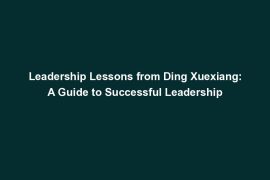Hey there, fellow history buffs and aspiring leaders! Today, we’re diving into the world of one of China’s most influential leaders, Chiang Kai-shek. If you’re not familiar with him, don’t worry – we’ll give you a quick background rundown.
Chiang Kai-shek was a key figure in Chinese history, known for his strong leadership style and strategic decision-making. Studying leaders like Chiang Kai-shek can actually provide us with some valuable insights into leadership practices that we can apply in our own lives. That’s right – history isn’t just about memorizing dates and facts, it’s about learning from the past to shape the future.
In this blog post, we’ll explore the key leadership lessons we can learn from Chiang Kai-shek. From adaptability to strategic vision, we’ll break down how his leadership style influenced his decisions and ultimately shaped his legacy. So grab a cup of tea, get cozy, and let’s delve into the fascinating world of historical leadership – you won’t want to miss this!
Leadership Lesson 1: Adaptability
One of the key lessons we can learn from Chiang Kai-shek’s leadership is adaptability. Chiang Kai-shek was a master at navigating through changing circumstances and complex political environments. He understood the need to be flexible and adjust his strategies in order to achieve his goals.
For example, during the Chinese Civil War, Chiang Kai-shek faced numerous challenges, including attacks from warlords, Japanese invaders, and Communist forces. Despite these obstacles, he was able to adapt his military tactics, form alliances, and make strategic decisions that ultimately helped him maintain control and lead the Nationalist government.
Modern leaders can apply similar principles of adaptability in their own leadership roles. In today’s fast-paced and ever-changing world, the ability to pivot, innovate, and adjust to new circumstances is essential for success. By learning from Chiang Kai-shek’s example, leaders can develop the flexibility and agility needed to tackle challenges and achieve their objectives.
How to Apply Adaptability in Your Leadership Role
One practical way to enhance adaptability is to regularly assess the current situation, anticipate potential changes, and be willing to adjust your strategies accordingly. This could involve seeking input from team members, monitoring industry trends, and staying open to new ideas and perspectives.
Additionally, cultivating a growth mindset can help leaders embrace change and view setbacks as opportunities for learning and improvement. By fostering a culture of adaptability within your organization, you can better respond to challenges, seize opportunities, and drive success in a rapidly evolving world.
Leadership Lesson 2: Strategic Vision
When it comes to leadership, having a clear strategic vision is crucial for success. Chiang Kai-shek was a master at looking ahead and setting long-term goals for China. His strategic thinking and planning not only helped him overcome challenges but also paved the way for the country’s future growth and prosperity.
Chiang Kai-shek envisioned a modern and unified China, free from foreign interference and internal conflicts. He strategically aligned himself with key allies and made tough decisions to steer the country towards his vision. For example, he implemented economic reforms to boost the country’s infrastructure and strengthen its military capabilities to protect against external threats.
How to Develop a Strategic Vision
To develop a strategic vision as a leader, it’s important to first define your long-term goals and objectives. Consider where you want your organization to be in the next five, ten, or twenty years. This will help you set a clear direction and focus your efforts on achieving your vision.
Next, create a roadmap outlining the steps needed to reach your goals. Break down your vision into smaller, manageable tasks and set timelines for each milestone. This will help you track progress and make adjustments as needed along the way.
Implementing Your Strategic Vision
Once you have a strategic vision in place, it’s important to communicate it effectively to your team. Make sure everyone understands the vision and their role in achieving it. Encourage open communication and collaboration to drive momentum towards your goals.
Monitor progress regularly and be willing to pivot if necessary. Adaptability, as we discussed in the previous section, is key to successfully implementing a strategic vision. Stay focused on the end goal but be flexible in your approach to navigate any obstacles that may arise.
In conclusion, developing and implementing a strategic vision is essential for effective leadership. By studying Chiang Kai-shek’s strategic thinking and planning, we can learn valuable lessons on how to set long-term goals, overcome challenges, and achieve success as leaders. So, take inspiration from Chiang Kai-shek and start shaping your own strategic vision today!



